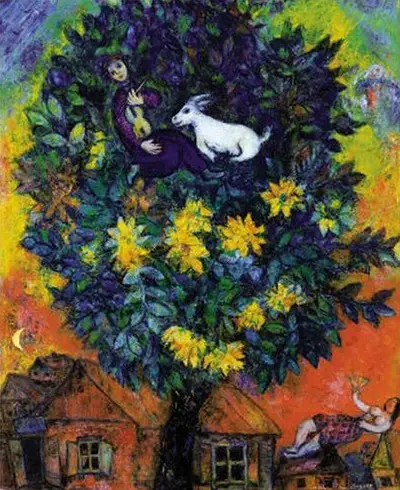The painting features memories of life in Russia, where Chagall was born. The rustic scenes include human and animal characters, and represents a feeling of blissful security that was no doubt in question during wartime.
The nostalgic painting reflects Surrealist principles, which at the time had replaced Cubism. Chagall often found himself at odds with Surrealism. While the movement embraced the dreamy visions and non-rational elements of his work, the painter saw Surrealism’s embrace of the power of the unconscious as disingenuous.
Autumn in the Village evokes similar imagery in other works created by Chagall, who often blended nostalgia with fantasy. The painting almost appears to be a chaotic vision from a dream, much like other paintings by Chagall.
The artist saw dreams as a reality, even going so far as believing a person’s dreams or unconscious was perhaps as real or more so than the outside world.
Painted in 1911, I and the Village is a narrative of the artist's childhood memories while growing up in Vitebsk, Russia. Like Autumn in the Village, it is a dream-like scene recalling Russian folk stories and landscapes.
I and the Village uses elements from the Cubism movement and combines overlapping and frantic images, including an upside-down violist and a green-faced man starting at a sheep. Hidden in the painting is St. Andrew’s cross.
Born in 1887, Marc Chegall was a Russian-French artist and a leading Jewish painter. His works are found around the world, include the Paris Opera’s Palais Garnier, the Art Institute of Chicago, the Metropolitan Opera and the Lincoln Centre in New York City, Metz Cathedral, Notre-Dame de Reims, Zurich’s Fraumünster Abbey, the Church of St. Stephan in Mainz, Hadassah Hospital in Jerusalem, and Chase Tower Plaza in Chicago.
The United Natiions Headquarters also has stained glass work by the artist. Chagall was one of the few artists to have his works displayed in the Louvre during their lifetime.
Born in present-day Belarus, Marc Chagall moved to Paris in 1910 before return to Russia during the revolution that brought communism to the country. He found himself back in France in 1923, where he remained until the early years of the Second World War. Chagall returned from the United States to his adopted homeland in 1948, where he lived until his death in 1985.
Chagall was known for his pioneering modernist works and used a variety of mediums and artistic styles. In addition to painting on canvas, Chagall was known for his book illustrations and fine art prints. He also worked with stained glass, ceramic, tapestries, and other formats. His imaginative works blended Cubism, Fauvism and Symbolism. Pablo Picasso noted Chagall as one of the few painters that truly understood colour.
His art was heavily influenced by his own religious beliefs and love for Russia. As a result, Chagall’s works often reflected Jewish and Russian folk culture, and many times included religious imagery. Village scenes, rural landscapes and life, and related figures were often dominate features of his art.
